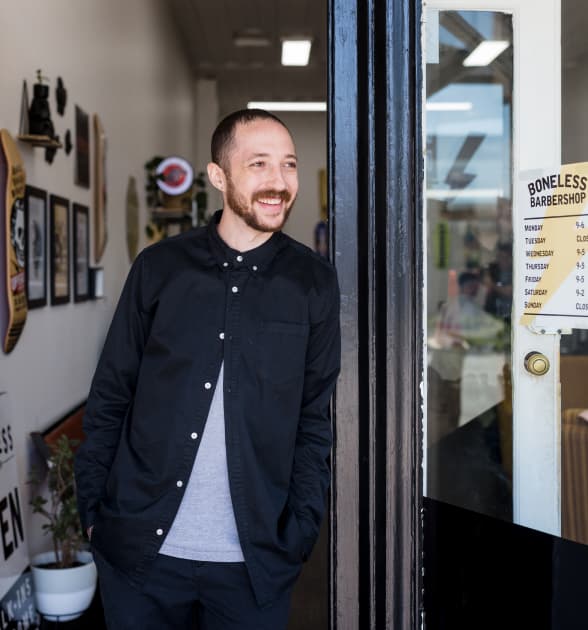
- Case Studies
Bar Positano: from Food Truck to Brick-and-Mortar Eatery
Meet the all-authentic Italian food truck navigating an expansion during COVID-19.
The evolution from popular mobile food truck to permanent bar, deli and cafe seems a natural progression for Bar Positano. After a successful eighteen months serving paninis, cheese boards, and other Italian delights from the bay window of their highly instagrammable van, co-owners Anthony Porra and Luca Andolfo decided to put down stumps in Sydney’s Surry Hills and shift their focus to the sit-down dining experience.
Although a sudden citywide lockdown threatened to derail the grand opening of Bar Positano’s new brick-and-mortar location, the duo were quick to adapt. Celebratory spritzes were swapped for takeaway cocktails and the deli was stocked with take-home pasta so locals could dish up their own cure for those holiday cravings.
We spoke to Luca and Anthony about the challenges they’ve faced so far, and why now’s the perfect time to bring a slice of the Amalfi Coast to Surry Hills.
Tell us a bit about how Bar Positano first started.
We first started out in the events industry, providing event hire and styling services for many weddings and other events. A lot of clients use pop-up food and drink vendors for a more casual style, so we decided to add a mobile bar to our offering. Being of Italian heritage, we thought we could offer a unique and authentic food truck, focusing on quality products and service for weddings, private and public events.
Then we were in Surry Hills one evening and saw the vacant shop, which had a nice unique style and a sunny corner position. Many Australians travel and love the Italian summer atmosphere, when it comes to alfresco dining and aperitivo. We’ve always wanted to bring that experience to Sydney, and thought this would be a perfect location to test our idea.

What was the biggest challenge you faced, establishing a permanent site?
Being a food truck, we always tailored our menu based on the event or location we were serving. We also kept to a limited menu, as it is always a challenge working within such a small space! Moving into a physical location made us really think about our target market and demographic, as well as a gap in the market which we wanted to target.
It is always challenging establishing a new business in a niche category, as you don’t know whether it will work or not. But we believe in it and really love it ourselves, so we just hope that everyone else does too.
How has COVID-19 impacted your business?
COVID-19 is a huge challenge to all businesses, but we decided to open up anyway as we wanted the community to see what we have to offer — albeit with a limited menu at the moment. We also sell smallgoods from the deli and pasta, sauces and other Italian products, which are a benefit to locals during lockdown.
It’s the right time for us, particularly because we are opening in winter — at a time people normally head off overseas for a summer holiday. Despite the current restrictions, we’re giving customers a feeling of being overseas on holiday, or eating and drinking what they normally would if they were in Italy. We have been lucky enough to receive support from the locals, grabbing something takeaway and supporting our new business.
.jpeg&w=1920&q=75)
What inspired you to make the switch to Zeller? How are you finding it?
What we were looking for was a reliable system that was simple to use in a fast-paced environment.
We love that the terminal not only looks good and suits our decor, but it is so simple to use with extremely low rates. The customer service and support is really great, the onboarding simple and straightforward, and the general daily use is so simple and reliable. Really happy we chose Zeller!
What have you learned about running a business, with everything going on this year?
To really think about our business concept, and how we can still be true to our brand and offering while remaining versatile so we can adapt as situations change. For instance, instead of sitting down to an antipasti board and Aperol Spritz — which is what we initially envisioned — we decided to advertise takeaway deals on our social profiles and package everything up, including the alcohol, so people can enjoy the same product at home, or wherever they may be.
It is so important to stay in touch with the community by communicating on social media, the website, and as best you can in store for anyone who passes by.
What’s next for Bar Positano?
We are really looking forward to opening our doors and having people sit down and enjoy the space. At the moment it feels like a bit of a tease, as we have only been offering takeaway coffees, panini, and a limited menu from the deli. It will be great to be able to operate at full capacity, for both our customers and staff.

Do you have any advice for other business owners at this time?
Stay positive, be creative and hang in there! The community is really supportive and tries to support as best they can.
Restrictions will eventually lift, so just take it day by day and be flexible with your product, trading hours, and how you operate your business.



